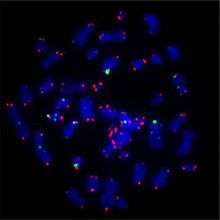HCT116 cells
HCT116 is a human colon cancer cell line used in therapeutic research and drug screenings.[1]
Characteristics
HCT116 cells have a mutation in codon 13 of the KRAS proto-oncogene, and are suitable transfection targets for gene therapy research.[2] The cells have an epithelial morphology and can metastasize in xenograft models.[1] When transducted with viral vectors carrying the p53 gene, HCT116 cells remain arrested in the G1 phase.[3] The proliferation of HCT116 colonies was found to be inhibited by 5-Fu/P85 copolymer micelles.[4] Furthermore, it was found that the knockout of MARCH2 limited growth of HCT116 cells via stress on the endoplasmic reticulum.[5]
Use in research
HCT116 cells are used in a variety of biomedical studies involving colon cancer proliferation and corresponding inhibitors. The cell line has been used in tumorigenicity studies, along with other research that has shown that Cyclin D1 holds large importance for the activity of lithocholic acid hydroxyamide. HCT116 cells can also function in xenografts, with docetaxel, 5-FU, and flavopiridol limiting tumor growth in vitro.
The HCT116 cell line was found to have two variations; one with a large expression of the Insp8 gene, and the other without. The Insp8 gene is part of a cell's energy metabolism process, and can affect the cellular phenotype as a result.[6]
References
- Rajput, Ashwani; et al. (15 June 2008). "Characterization of HCT116 Human Colon Cancer Cells in an Orthotopic Model". Journal of Surgical Research. 147 (2): 276–281. doi:10.1016/j.jss.2007.04.021. PMID 17961596.
- "HCT 116". ATCC. Retrieved 4 May 2018.
- Kaeser, Matthias; et al. (9 December 2003). "Regulation of p53 Stability and Function in HCT116 Colon Cancer Cells". Journal of Biological Chemistry. 279 (9): 7598–7605. doi:10.1074/jbc.M311732200. PMID 14665630.
- Zhu, Pengxi (11 February 2016). "Inhibition of Growth and Metastasis of Colon Cancer by Delivering 5-Fluorouracil-loaded Pluronic P85 Copolymer Micelles". Scientific Reports. 6: 20896. doi:10.1038/srep20896. PMC 4750032. PMID 26864651.
- Xia, Dan (27 July 2017). "Knockout of MARCH2 inhibits the growth of HCT116 colon cancer cells by inducing endoplasmic reticulum stress". Cell Death and Disease. 8 (7): e2957. doi:10.1038/cddis.2017.347. PMC 5584615. PMID 28749466.
- Gu, Chunfang (27 October 2016). "Inositol Pyrophosphate Profiling of Two HCT116 Cell Lines Uncovers Variation in InsP8 Levels". PLOS ONE. 11 (10): e0165286. doi:10.1371/journal.pone.0165286. PMC 5082907. PMID 27788189.
